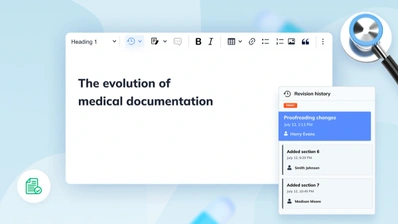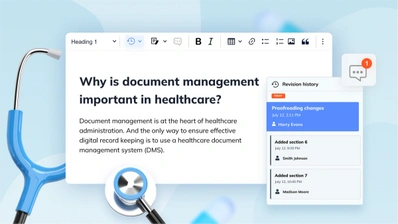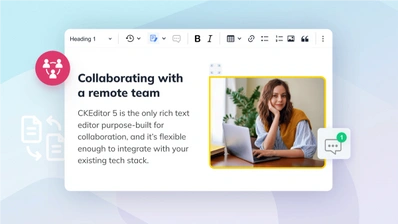How collaborative SaaS tools are reshaping modern healthcare

The digital transformation of today allows for easier communication and collaboration between patients and physicians. Clinical Management Systems (CMSs) – which I covered in the clinical trials section of a previous blog post related to Revision History use cases – allow physicians to keep tabs on patients in terms of what sort of illnesses they have, how the treatment is progressing, and the medications they are taking. However, it is not just software and apps that are providing the digitalization of healthcare and improving the treatment of diseases.
Research within the field is also benefiting the health industry due to the sharing of data and insight in order to find the best treatments. This is thanks to collaborative platforms like Learning Health Networks (LHN), sometimes called Learning Health Systems (LHS), which are used for greater collaboration to take place between healthcare professionals, and even patients, in the exchange of data and ideas for potential cures. Such collaboration allows for scalability within the healthcare field for other companies to consider with greater analytics potential to fund new medical solutions.
Both of these forms of patient care call for collaboration and a way for patients and physicians to be able to interact with one another for the best treatment, care and solutions in medicine. One healthcare organization and startup that provides LHN services is Hive Networks. The startup decided that a rich text editor with collaboration at the core is ideal for the task at hand. The company decided to implement CKEditor 5 within its SaaS application for text editing collaboration. However, there are many other examples as well of how healthcare SaaS is changing the entire healthcare industry.
Healthcare SaaS defined
Software as a service, or SaaS, is a way of delivering software or applications over the Internet through the use of cloud computing services in an on-demand fashion and often relying on a subscription model for revenue generation. You can access such software typically via a browser by going to the URL the web app is hosted at and run by the SaaS vendor. Even a simple email client, like Gmail, can be considered SaaS as it does not require end users or customers to download the software on a system it is accessed from.
In healthcare, SaaS continues to make its presence felt by healthcare companies and more cloud-based applications continue to be created within this market. Such SaaS trends will continue within the field. Security was for a long time a hurdle and applications tended to be hosted outside the walls of a company running the software in question. However, this has been improving and now industries such as healthcare are more trusting in the solutions SaaS provides.
Collaborative editors like CKEditor 5 can be integrated into one system or within the confines of a single SaaS solution. This can alleviate security concerns within this industry (known to be highly sensitive in this area due to aspects like patient records having to be private and secure) by relying on outside software for daily operations.
Learning health networks: example of medical SaaS technology setting new trends
Research is the driving force of finding the best solutions for ongoing care and eventually new cures or medical treatments for diseases. It helps to advance clinical research, trials and thus overall healthcare. Research usually is done by professionals in the healthcare field who are experts on the subject they specialize in.
However, a trend of the current digital world of healthcare involves going beyond just this form of research and this is thanks to LHNs. Current methods and software allow for not just researchers and medical professionals to interact with one another easily and over great distances, but for patients to also have their input heard and be part of this collaboration process.
The idea of having a network of physicians, patients and other health professionals collaborating on ideas to solve diseases is one aspect of the digital transformation that we are experiencing today. It involves sharing documents related to patients, their care and their responses to certain medications - as well as creating new outlines on potential future treatment. The potential here is to truly transform the way medical research is conducted through greater sharing of knowledge and collaboration. This is because it allows various individuals, such as medical professionals or patients, to have their input heard, finding out what works and what doesn’t.
The case of Hive Networks
One such case is that of Hive Networks. It offers an inclusive medical SaaS platform for collaboration, or as it calls it “a working community” that focuses on finding treatment for pediatric diseases through the exchange of ideas. This involves a social community with both patients and healthcare providers being a part of it.
It acknowledges that such a community may be less trustworthy and focused when compared to a research network since researchers are professionals with credentials. Their approach however tends to be siloed, and combining them with patients can create the best field for the exchange of ideas and this is what it refers to again as the working community.
Hive Networks decided to integrate CKEditor 5 into its system for document collaboration and the sharing of ideas alongside data related to care. The system relies on collaboration in the way the exchange of ideas occurs. It does so using notes, documents and the written word with CKEditor 5 at the core.
“The driving force behind Hive’s platform is the concept of iterative improvement, a form of problem-solving that encourages input from multiple parties,” according to CKSource’s case study.
This company saw a gap in the healthcare market when analyzing software that facilitates communication between patients and caregivers. This was due to such software mostly just focusing on specific tasks or niches and being siloed off from other aspects of greater collaboration.
“Hive’s approach is to amplify the effects of these capabilities by having them all on one platform where all parties involved can debate, hash out details, and create strategies in a Google Docs-like environment”, according to the case study. “The result is a learning health network working in tandem to generate the knowledge necessary to combat pediatric diseases.”
The LHNs all have some sort of collaboration present and the idea of sharing patient data with one another. Thus, document sharing and in many cases collaborating on documents and researchers being able to work together across great distances to solve medical problems is what drives these platforms.
Having widespread and accessible data is key for research projects to be successful.
This data comes from clinical registries and from routinely-collected sources of medical information. Note-taking and jotting down of data in an electronic, or rich-text, fashion is something that is now possible thanks to editors like CKEditor 5.
A rich text editor like CKEditor 5 is also up to the challenge of being a part of a modern LHN. This is due to how flexible it is not just with collaboration, including real-time collaboration, but with the ability to make changes to documents on the fly and down the line. It does this through its features like Track Changes and can be integrated into existing LHN systems. Also, if audit checks are needed within any of the research or how results were gathered, it has Revision History for this role.
Results that can be attributed to the use of collaborative tools
LHNs are leading the charge in many ways on finding the optimal solutions to a wide range of alignments, diseases, and overall health issues today. For example, according to Hive, a 40% reduction in mortality (or death rate) for children born with single ventricle congenital heart disease occurred due to using the LHN.
These are just some examples of impressive results that can be achieved when greater collaboration occurs and the sharing of data amongst professionals within the healthcare field in order to find the best results and outcomes for future care.
Learning Health Networks offer a way to make data easier to access across the field and allow for a greater form of collaboration between researchers and even patients and physicians. It is also proving successful in finding ways to address health issues and improve the field as a whole.u
A robust rich text editor like CKEditor 5 with collaboration at the core can also make all the difference between a successful Learning Health Network and one that is out of date and out of fashion. The healthcare field continues to be digitized and this brings it the need to have a rich text editor up to the task of the modern day.
Healthcare SaaS continues to grow exponentially
Software and healthcare, with the use of cloud technologies, is a thriving field that continues to show new ways healthcare practitioners can interact with patients and researchers in order to collaborate on new treatment methods and patients themselves can get the best results in telemedicine, which was unseen in previous decades. The previously-mentioned, Clinical Management Systems, is another example of the digitization of healthcare records and the overall running of healthcare facilities in a modern way.
Telemedicine truly shows the transformation of the healthcare field with the use of software, such as medical SaaS, to make patients’ and physicians’ lives easier and being able to accomplish things, like check in on patients remotely easier or make sure they are getting the correct dosages of medicines. This sort of remote care can be instrumental during pandemics (or other hardships) - with hospitals overblown with patients, like during the recent Covid-19 pandemic.
Some other examples of what today’s telemedicine can bring to the table include interaction between patients and physicians over phone or video chat; sending and receiving messages or instructions between physician and patient; remote monitoring of patients; remote mental-health counseling and being able to reduce the wait time for a visit by checking in electronically.
According to Zion Market Research, the global healthcare cloud computing market was valued at about $18.85 billion in 2018 and is expected to grow to $61.84 billion by 2025.
The future for healthcare SaaS should be bright. This market will continue to grow with new technologies being created while aiding the lives of patients, healthcare professionals and researchers being created. Hive Networks proved how such a platform within the industry can be beneficial for creating new treatments. Its working communities platform uses CKEditor 5 to the fullest and shows how rich text editors like this, with strong support for collaboration, can aid SaaS platforms within the healthcare industry and do it all within the confines of a single platform or application.
For more information on implementing CKEditor 5 within your healthcare software, please contact us here.
You can read more on the topic of collaboration in our blog posts:
- Real-time collaboration - 7 greatest benefits - CKEditor 5
- How collaboration lets companies innovate more and better - CKEditor 5
- Tackle too many unproductive meetings - CKEditor 5
- Best practices of remote work are at CKSource - Come join us!
- Content collaboration best practices in a nutshell - CKEditor 5
- Remote collaboration - Software that improves working from home - CKEditor 5
- Collaborative writing and how to implement it in your application
- Document collaboration tools - how to break down barriers to success


